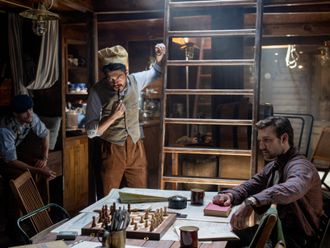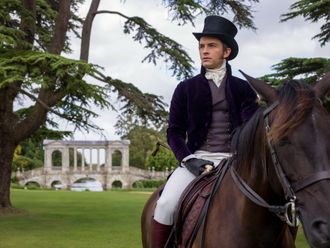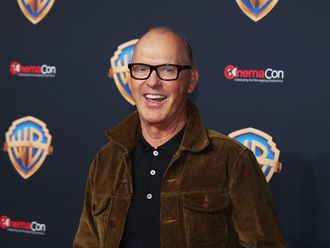The subtitle of Last Girl Before Freeway, Leslie Bennetts’s biography, is The Life, Loves, Losses, and Liberation of Joan Rivers. I’d add the word “lows,” because Rivers didn’t just hit rock bottom; she bounced on it like a rubber ball, up and down, up and down. The book opens with one of the lowest lows, after Rivers’s husband, Edgar Rosenberg, committed suicide in 1987. They had met in 1965 not long after her debut on The Tonight Show, once comedy’s highest altar. Johnny Carson had roared at her routine, announcing her arrival. She became a favourite of his, and when he made her the show’s first permanent guest host in 1983, she seemed in line for his crown.
Last Girl Before Freeway tracks the arc of Rivers’s life by revisiting milestones like her childhood, marriage and famous break with Carson after she landed her own late-night talk show on the newly created Fox network, becoming the first woman to secure a gig historically held by men. (Right now Samantha Bee is the only woman with her own late-night comedy show.) The book tracks her later fame, too, first as a shill for the QVC shopping network and then as the host for the cable show Fashion Police, where, until she died in 2014, she presided over a panel that judged and eviscerated the famous and pseudofamous on their red-carpet looks.
There is a lot here that’s familiar, especially if you’ve seen some of the documentaries or read some of the books that Bennetts draws from. The author of The Feminine Mistake, Bennetts began interviewing her sources for this book the month that Rivers died, and it suffers from a lack of original interviews with its subject. Rivers talks a lot here, but because her comments are from extant sources, she often sounds canned — and always on, whether delivering tears or laughs. Perhaps there was no other Rivers and her life was just a long-running act. Except that every so often Bennetts finds something that sounds like a real person, as with a quotation from Rivers’ 1986 best seller Enter Talking in which she confesses to not wanting to end up as “ordinary Joan Molinsky”.
Plastic surgery
Her full name was Joan Alexandra Molinsky, and it’s unlikely that Rivers ever left her behind. This other Joan — the girl with the larger nose and “dull mouse-brown hair,” as Bennetts puts it — seems to have been always there, forcing Rivers to keep going, to keep changing, to keep scrambling. You could call this showbiz ambition, with the usual hair dye and lots of plastic surgery. Still, even grasping ambition doesn’t explain what made Rivers so angry, a trait that at times became her defining quality. Bennetts has some ideas, mostly having to do with Rivers’s unhappiness with her looks, though there’s also her historical moment: She was born into an old-fashioned world, yet at the same time, she was shaped by larger forces, notably feminism.
There are so many different versions of Joan Rivers in this book that it’s hard to keep track: the smother-mother, the widow, the survivor. But one who’s conspicuously absent is the woman who proudly declared herself a feminist to Playboy in 1986, who, in muscling into a male world, grasped that she was liberating herself and others. Bennetts does cite those who assert that Rivers “overcame the prejudice against women,” “opened up the door — and not just for women” and “did something new: She spoke the truth about women’s feelings.” But Bennetts writes that Rivers tended to avoid that other “F” word, even if her friend Kathy Griffin says that Rivers “broke barriers; she did everything a feminist does.” Rivers did something else that surely a feminist would never do: She sold out other women for laughs.
Resilience
Of course Rivers made that into a trademark — comedy is cruel and so was she. And if there’s one thing Bennetts does in this book it is to make the case for that Rivers — the opportunistic bully, the hater. The problem is that she’s set out to write about “a living embodiment of courage, ingenuity and resilience for every woman who faces unexpected hardships.” That woman appears in Last Girl Before Freeway, specifically after the death of Rivers’s husband, but Joan the Revolutionary is outflanked by Joan the Impaler, “one of the world’s most uninhibited mean girls,” as Bennetts calls her, who “focused her rage on ridiculing other women.” That Rivers is exhausting, periodically infuriating and a reminder that feminists are as complex and contradictory as everyone else.
Old or young, dead or alive, everyone was fair game to Rivers. For years, she took open delight in savaging Elizabeth Taylor, whose weight had been a topic of public sport for decades. Who needs men when you have other women to do this kind of dirty work, right? That sounds harsh, but there seems to have been no such thing as too much when it concerns the Rivers who appears in Last Girl Before Freeway. Yet in her excesses, Rivers comes across as a strange sister to Taylor, a woman who was partly defined by her voluptuous excesses and who ate, drank, loved and, of course, married lavishly. The world (and Rivers) mocked Taylor’s appetites, but they were also a declaration of independence, acts of resistance against efforts to rein her in, to make her obey certain rules about acceptable, controlled, polite femininity. In her way, Taylor pushed back against conformity — just like Rivers.
Bennetts has a tough time reconciling Joan the Impaler with Joan the Revolutionary, and the book pings and pongs with journalistic on-the-one-hand, on-the-other equivocation. The way that Bennetts lets some of her sources run on without critical comment suggests that she doesn’t much like Rivers. That isn’t a prerequisite for a biographer, and it wouldn’t be an issue here if Bennetts shifted into deeper critical mode more often. Too frequently, though, she lets others cut loose, appallingly. That’s never truer than in the sections involving Rivers’s husband, who ended up flailing in his wife’s shadow. “My personal take was that she felt she was better off without him,” says a Rivers colleague. “The marriage was kind of over, and there would never have been a QVC with Edgar around.” Clown
It’s instructive that Rivers was always one of her own favourite targets. “Before we make love,” she cracked, “my husband takes a painkiller.” Comics mine their lives for material, and for some funny women who came of age before second-wave feminism that meant raiding their kitchens and bedrooms. Rivers certainly did. Yet while she turned domesticity into laughs, she didn’t turn herself into a clown like Phyllis Diller or a dizzy, futilely striving housewife, like the one Lucille Ball played. The early Rivers, in her cocktail dresses and pearls, seemed to be playing a version of herself, the wised-up funny lady who made jokes about sex on the linoleum because she knew it was far better to make jokes about that floor than to scrub it. Her success was its own way out.
The title Last Girl Before Freeway is borrowed from one of Rivers’ self-flagellating jokes about her mother being desperate to marry her daughter off. Outside the house “she has a sign up: ‘Last girl before freeway’. These put-downs could seem like desperate reassurances that the jokes were always on her, too, but Rivers was also shining a hard light on men, women and gender. “A girl, you’re 30 years old, you’re not married — you’re an old maid,” she said. “A man, he’s 90 years old, he’s not married — he’s a catch.” Bennetts writes that as Rivers’ “success grew, her perspective began to shift from victim to oppressor.” You could argue that like certain women of privilege she remained victim and oppressor both, just another bird, both singing and flapping in her cage.












